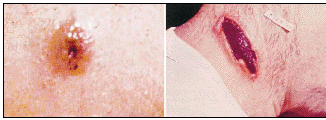|
Anthrax:
A Primer
Cutaneous
anthrax usually begins 2 to 5 days after inoculation of spores
in an exposed part of the body. The initial lesion is a red papule,
which may be mistaken for an insect bite. The papule usually progresses
through vesicular and ulcerative stages over 7 to 10 days to form
a black scab surrounded by edema. Associated systemic symptoms
are usually mild, and the lesion typically heals after the scar
separates. Less commonly, the disease progresses with massive
local edema, toxemia, and bacteria, and a fatal outome if untreated.
In
the United States, 224 cases of cutanous anthrax were reported
between 1944 an 1994. The largest reported epidemic occurred in
Zimbabwe between 1979 and 1985, when more than 10,000 human cases
of anthrax were reported, nearly all of them cutaneous.
 |
Left:
Forearm lesion on day 7 of illness shows vesiculation and
ulceration of the initial red area.
Right:
Eschar or black scab of the neck on day 15 of illness is
typical of the last stage of the lesion before it resolves
over 1 to 2 weeks.
|
|